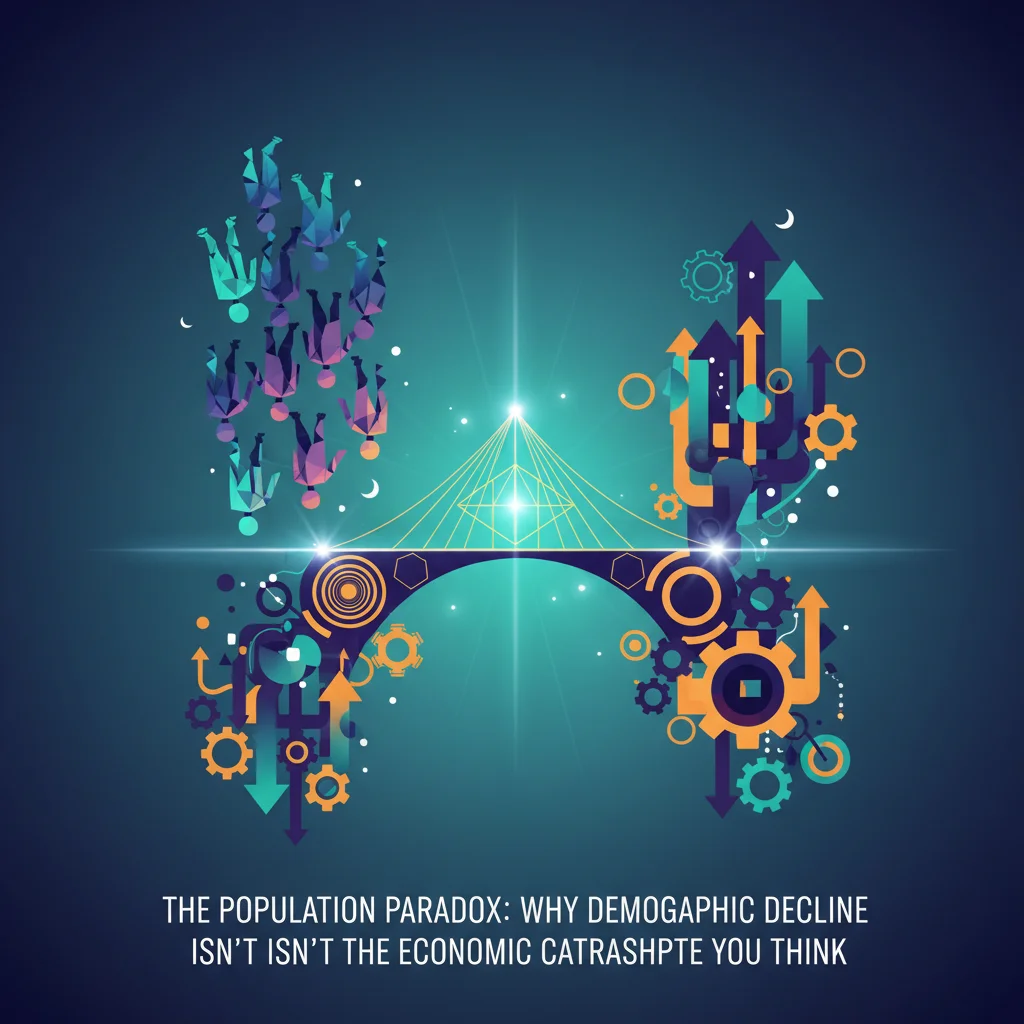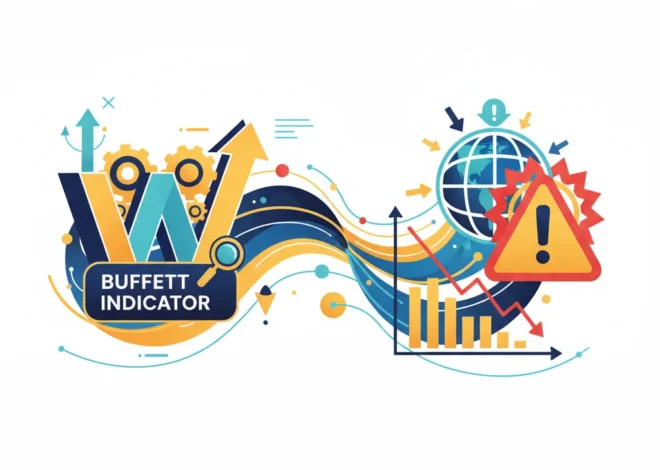
The Population Paradox: Why Demographic Decline Isn’t the Economic Catastrophe You Think
The Echo Chamber of Demographic Doom
Turn on the news or scroll through your financial news feed, and you’ll likely encounter a familiar, ominous narrative: the “demographic time bomb.” Headlines warn of collapsing birth rates, a “silver tsunami” of retirees, and an impending economic winter. The story goes that with fewer young people to work, innovate, and pay taxes, our economies are destined for stagnation, our pension systems for collapse, and our stock market for a perpetual bear run. It’s a compelling, fear-inducing story. But is it the whole story?
Frankly, this brand of demographic doom-mongering isn’t just overly pessimistic; it’s a dangerous oversimplification. As financial journalist Tim Harford aptly notes, it’s highly unlikely that “the human race is going to become the first species in recorded history that chooses to go extinct” (source). The narrative of self-inflicted extinction ignores the complex, rational decisions individuals make and, more importantly, overlooks humanity’s remarkable capacity for adaptation. Instead of panicking about a shrinking population, it’s time for investors, business leaders, and policymakers to look past the alarmism and identify the profound opportunities embedded within this global shift.
This isn’t to say the challenges aren’t real. They are. But framing them as an unavoidable apocalypse prevents us from doing the necessary work: adapting our economic models, rethinking our investment strategies, and leveraging technology to build a more prosperous, sustainable future on a less crowded planet.
A History of Flawed Prophecies
Worrying about population has a long and rather unimpressive history. In the late 18th century, Thomas Malthus famously predicted that population growth would outstrip food supply, leading to widespread famine. In 1968, Paul Ehrlich’s bestseller, The Population Bomb, forecasted “an utter breakdown in the capacity of the planet to support humanity” (source). These prophecies of doom failed to materialize because they made a critical error: they underestimated human ingenuity. Agricultural revolutions, technological breakthroughs, and shifts in global trade rendered their models obsolete.
Today’s demographic doomsayers are at risk of making the same mistake. They see falling fertility rates and an aging population as a simple equation leading to economic ruin. What they fail to properly factor in is our ability to adapt through policy, technology, and a fundamental re-evaluation of what “economic success” even means.
The core issues—funding pensions and healthcare for a larger elderly population with a smaller workforce—are significant logistical and financial challenges, not existential threats. They are problems of allocation and efficiency, precisely the kind of problems that innovative sectors like financial technology (fintech) and forward-thinking economic policy are equipped to solve.
Beyond the Missing Parcel: How US Shipping Chaos Signals Deep Cracks in the Global Economy
Recasting the Economic Equation: Two Competing Views
To understand the path forward, it’s helpful to contrast the alarmist view with a more pragmatic, opportunity-focused perspective. The challenges are the same, but the interpretation and proposed solutions are worlds apart.
| Economic Factor | The “Demographic Doom” View | The “Pragmatic Adaptation” View |
|---|---|---|
| GDP Growth | Overall GDP will stagnate or shrink as the workforce declines, hurting the stock market. | Focus shifts from total GDP to GDP per capita. A smaller, more productive population can enjoy a higher standard of living. |
| Innovation | Fewer young people means less dynamism, risk-taking, and new ideas. | Necessity is the mother of invention. A shrinking labor force will accelerate investment in automation, AI, and productivity-enhancing fintech. |
| Social Security/Pensions | The system is a Ponzi scheme destined to collapse as the ratio of workers to retirees plummets. | The system requires reform: adjusting retirement ages, encouraging private investing, and creating more flexible work models for older adults. |
| Labor Markets | Chronic labor shortages will cripple industries and curb production. | Labor shortages will drive up wages, improve working conditions, and incentivize companies to invest in employee training and technology. Immigration becomes a key strategic asset. |
| Asset Prices | An aging population will sell assets (homes, stocks) to fund retirement, causing a market crash. | Shifts in demand create new markets. The “silver economy“—healthcare, leisure, and specialized financial services for seniors—will boom. |
First, automation and robotics are no longer just about efficiency; they’re about necessity. Companies that provide the hardware and software to augment a smaller workforce are poised for massive growth. Second, the entire healthcare and biotech sector is a direct beneficiary. Think beyond traditional pharma to areas like telehealth, personalized medicine, and assistive technologies for aging in place.
Finally, the world of finance and banking itself must transform. Wealth management for a generation with a 30-year retirement horizon is fundamentally different. Financial technology platforms that offer sophisticated, low-cost retirement planning and decumulation strategies will be in high demand. The “silver economy” isn’t just a niche; it’s the future of the consumer market in the developed world. The key is to stop investing based on outdated models of population growth and start focusing on the per-capita prosperity and technological adaptation that will define the next economic era.
The Triple Engine of Adaptation: Immigration, Longevity, and Technology
Overcoming the challenges of an aging population isn’t about forcing people to have more children. It’s about intelligently managing three powerful levers of adaptation.
1. Strategic Immigration
For countries with falling birth rates, immigration is the most direct tool to supplement the workforce and inject cultural and economic dynamism. Welcoming skilled workers, entrepreneurs, and young families is not just a social policy but a core economic strategy. Countries that create clear, efficient pathways for immigration will gain a significant competitive advantage over those that close their borders. This replenishes the tax base, fills critical labor gaps, and brings new ideas into the economy.
2. The Longevity Dividend
We are not just living longer; we are living healthier for longer. The concept of a rigid retirement at 65 is an artifact of the 20th century. A more flexible approach allows experienced workers to continue contributing, whether through part-time work, mentorship, or entrepreneurship. This “longevity dividend” harnesses the wisdom and skills of a vast demographic, turning a perceived liability into a potent asset. Forward-thinking companies are already redesigning roles and workplaces to accommodate and attract older, highly-skilled employees.
The Fall of a Titan: René Benko's Courtroom Drama and the Lessons for Modern Finance
3. The Technology Accelerator
This is the most powerful lever of all. Concerns about a shrinking workforce seem almost quaint in the age of AI, robotics, and advanced automation. These technologies are productivity multipliers. A single worker equipped with AI-powered tools can achieve what once required a team. In the banking sector, for example, AI algorithms can handle complex risk analysis and customer service tasks, freeing up human advisors for high-value strategic work. The rise of decentralized finance built on blockchain technology promises to streamline entire financial systems, reducing the need for vast back-office workforces. This technological revolution is perfectly timed to offset demographic pressures, enabling us to produce more with fewer people.
A recent study highlighted that automation could boost productivity growth globally by up to 1.4% annually (source), a figure that directly counters the narrative of inevitable stagnation.
Conclusion: From Demographic Panic to Pragmatic Prosperity
The global demographic shift is real and its implications are profound. An aging population will reshape everything from consumer markets and labor dynamics to public finance and investment strategies. But this transformation is not a pre-written tragedy. It is a challenge that calls for ingenuity, adaptation, and a shift in perspective.
The relentless focus on “demographic doom” is a distraction. It encourages short-term panic rather than long-term strategic planning. The real work lies in building resilient, flexible systems that can thrive in this new reality. This means creating smart immigration policies, fostering lifelong learning and flexible work, and aggressively investing in the productivity-enhancing technologies that will define the 21st-century economy.
For investors and business leaders, the message is clear: stop mourning the high-growth models of the past and start capitalizing on the high-value opportunities of the future. The winners in this new era will be those who understand that prosperity is not solely a function of population size, but of productivity, innovation, and the quality of life we can provide for every citizen, young and old.


